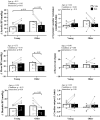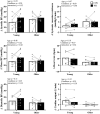Short-term water deprivation attenuates the exercise pressor reflex in older female adults
- PMID: 32965797
- PMCID: PMC7510566
- DOI: 10.14814/phy2.14581
Short-term water deprivation attenuates the exercise pressor reflex in older female adults
Abstract
Older adults have reduced fluid intake and impaired body fluid and electrolyte regulation. Older female adults exhibit exaggerated exercise blood pressure (BP) responses, which is associated with an increased risk of adverse cardiovascular events. However, it is unclear if dysregulated body fluid homeostasis contributes to altered exercise BP responses in older female adults. We tested the hypothesis that short-term water deprivation (WD) increases exercise BP responses in older female adults. Fifteen female adults (eight young [25 ± 6 years] and seven older [65 ± 6 years]) completed two experimental conditions in random crossover fashion; a euhydration control condition and a stepwise reduction in water intake over three days concluding with a 16-hr WD period. During both trials, beat-to-beat BP (photoplethysmography) and heart rate (electrocardiogram) were continuously assessed during rest, handgrip exercise (30% MVC), and post-exercise ischemia (metaboreflex isolation). At screening, older compared to young female adults had greater systolic and diastolic BP (p ≤ .02). Accelerometer-assessed habitual physical activity was not different between groups (p = .65). Following WD, 24-hr urine flow rate decreased, whereas thirst, urine specific gravity, and plasma osmolality increased (condition: p < .05 for all), but these WD-induced changes were not different between age groups (interaction: p ≥ .31 for all). Resting systolic and diastolic BP values were higher in older compared to young adults (p < .01 for both), but were not different between experimental conditions (p ≥ .20). In contrast to our hypothesis, WD was associated with attenuated systolic BP responses during handgrip exercise (post hoc: p < .01) and post-exercise ischemia (post hoc: p = .03) in older, but not young, female adults. These data suggest that reduced water intake-induced challenges to body fluid homeostasis do not contribute to exaggerated exercise BP responses in post-menopausal female adults.
Keywords: aging; exercise pressor reflex; hypohydration.
© 2020 The Authors. Physiological Reports published by Wiley Periodicals, Inc. on behalf of The Physiological Society and the American Physiological Society.
Conflict of interest statement
The authors report no competing interests regarding the current article.
Figures





Similar articles
-
Short-term water deprivation does not increase blood pressure variability or impair neurovascular function in healthy young adults.Am J Physiol Regul Integr Comp Physiol. 2020 Jan 1;318(1):R112-R121. doi: 10.1152/ajpregu.00149.2019. Epub 2019 Oct 16. Am J Physiol Regul Integr Comp Physiol. 2020. PMID: 31617739 Free PMC article. Clinical Trial.
-
Water deprivation does not augment sympathetic or pressor responses to sciatic afferent nerve stimulation in rats or to static exercise in humans.J Appl Physiol (1985). 2019 Jul 1;127(1):235-245. doi: 10.1152/japplphysiol.00005.2019. Epub 2019 May 9. J Appl Physiol (1985). 2019. PMID: 31070954 Free PMC article.
-
Reduced blood pressure responsiveness to skeletal muscle metaboreflex activation in older adults following inorganic nitrate supplementation.Nitric Oxide. 2018 Aug 1;78:81-88. doi: 10.1016/j.niox.2018.05.010. Epub 2018 Jun 1. Nitric Oxide. 2018. PMID: 29864505 Clinical Trial.
-
Age-related alterations in the cardiovascular responses to acute exercise in males and females: role of the exercise pressor reflex.Front Physiol. 2023 Nov 2;14:1287392. doi: 10.3389/fphys.2023.1287392. eCollection 2023. Front Physiol. 2023. PMID: 38028783 Free PMC article. Review.
-
Influence of age on thirst and fluid intake.Med Sci Sports Exerc. 2001 Sep;33(9):1524-32. doi: 10.1097/00005768-200109000-00016. Med Sci Sports Exerc. 2001. PMID: 11528342 Review.
Cited by
-
Vascular limitations in blood pressure regulation with age in women: Insights from exercise and acute cardioselective β-blockade.Exp Physiol. 2025 Jan;110(1):93-105. doi: 10.1113/EP091843. Epub 2024 Oct 4. Exp Physiol. 2025. PMID: 39365983 Free PMC article.
-
The effects of body hydration on perceptual responses during blood flow restriction exercise.Physiol Rep. 2025 Apr;13(8):e70343. doi: 10.14814/phy2.70343. Physiol Rep. 2025. PMID: 40260831 Free PMC article.
-
Acute nasal breathing lowers diastolic blood pressure and increases parasympathetic contributions to heart rate variability in young adults.Am J Physiol Regul Integr Comp Physiol. 2023 Dec 1;325(6):R797-R808. doi: 10.1152/ajpregu.00148.2023. Epub 2023 Oct 23. Am J Physiol Regul Integr Comp Physiol. 2023. PMID: 37867476 Free PMC article.
-
When it's time for the sex talk, words matter.Am J Physiol Heart Circ Physiol. 2022 Jan 1;322(1):H66-H70. doi: 10.1152/ajpheart.00556.2021. Epub 2021 Nov 19. Am J Physiol Heart Circ Physiol. 2022. PMID: 34797173 Free PMC article.
-
Hypohydration attenuates increases in creatinine clearance to oral protein loading and the renal hemodynamic response to exercise pressor reflex.J Appl Physiol (1985). 2024 Mar 1;136(3):492-508. doi: 10.1152/japplphysiol.00728.2023. Epub 2024 Jan 11. J Appl Physiol (1985). 2024. PMID: 38205553 Free PMC article.
References
-
- Bevilacqua, M. , Norbiato, G. , Chebat, E. , Raggi, U. , Cavaiani, P. , Guzzetti, R. , & Bertora, P. (1987). Osmotic and nonosmotic control of vasopressin release in the elderly: Effect of metoclopramide. The Journal of Clinical Endocrinology and Metabolism, 65, 1243–1247. - PubMed
-
- Brooks, V. L. , Qi, Y. , & O'Donaughy, T. L. (2005). Increased osmolality of conscious water‐deprived rats supports arterial pressure and sympathetic activity via a brain action. American Journal of Physiology‐Regulatory, Integrative and Comparative Physiology, 288(5), R1248–R1255. 10.1152/ajpregu.00638.2004 - DOI - PubMed
Publication types
MeSH terms
Grants and funding
LinkOut - more resources
Full Text Sources
Medical

